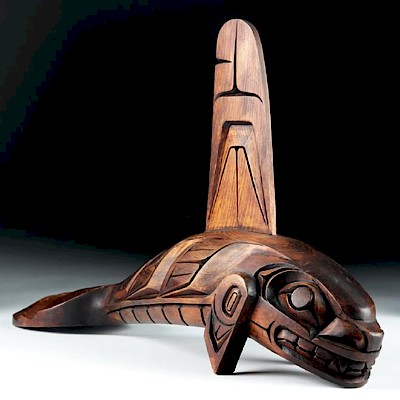Aztec Polychrome Footed Bowl - Gods and Trophy Heads
Lot 123
About Seller
Artemis Fine Arts
686 S Taylor Ave, Ste 106
Louisville, CO 80027
United States
Selling antiquities, ancient and ethnographic art online since 1993, Artemis Gallery specializes in Classical Antiquities (Egyptian, Greek, Roman, Near Eastern), Asian, Pre-Columbian, African / Tribal / Oceanographic art. Our extensive inventory includes pottery, stone, metal, wood, glass and textil...Read more
Estimate:
$5,000 - $7,500
Absentee vs Live bid
Two ways to bid:
- Leave a max absentee bid and the platform will bid on your behalf up to your maximum bid during the live auction.
- Bid live during the auction and your bids will be submitted real-time to the auctioneer.
Bid Increments
| Price | Bid Increment |
|---|---|
| $0 | $25 |
| $300 | $50 |
| $1,000 | $100 |
| $2,000 | $250 |
| $5,000 | $500 |
| $10,000 | $1,000 |
| $20,000 | $2,500 |
| $50,000 | $5,000 |
| $100,000 | $10,000 |
| $200,000 | $20,000 |
About Auction
By Artemis Fine Arts
May 24, 2018
Set Reminder
2018-05-24 10:00:00
2018-05-24 10:00:00
America/New_York
Bidsquare
Bidsquare : Northwest Coast, Tribal, & Pre-Columbian Art
https://www.bidsquare.com/auctions/artemis-gallery/northwest-coast-tribal-pre-columbian-art-3238
Featuring Pacific Northwest Coast Native American Art from respected collector / dealer, Joseph Alphabet. Artemis Fine Arts info@artemisfinearts.com
Featuring Pacific Northwest Coast Native American Art from respected collector / dealer, Joseph Alphabet. Artemis Fine Arts info@artemisfinearts.com
- Lot Description
Pre-Columbian, Mexico, Aztec Empire, ca. 1400 to 1521 CE. A remarkably preserved and elaborately painted bowl depicting a dancing lord surrounded by a border of repeated trophy heads. The bowl has an integrated round platform foot, ringed with round, wheel-like motifs. The painting style, especially on the interior of the bowl, demonstrates the dense, fractal imagery that made up the Aztec visual language. Rich reds, oranges, browns, and whites within black outlines create the motifs. Polychrome vessels like this one seem to have been reserved for elites, and were often made in the Aztec hinterlands and traded to Tenochtitlan. Size: 8.55" W x 2.95" H (21.7 cm x 7.5 cm)
Why are these trophy heads? The Aztec, like their neighbors the Mixtec and other cultural groups throughout the Valley of Mexico, fought constant wars to acquire prisoners. Captives and sacrificial victims had their heads removed ritually, and these were displayed publicly on specially-built racks called tzompantli. In addition to having real racks of skulls, documented extensively by Spanish chroniclers, Mesoamericans created artwork of disembodied heads that seem to relate to the same idea.
Provenance: private Hawaii, USA collection; ex Stuart Gentling collection, Texas, USA, painter of George W. Bush's portrait in the Texas State Capitol
All items legal to buy/sell under U.S. Statute covering cultural patrimony Code 2600, CHAPTER 14, and are guaranteed to be as described or your money back.
A Certificate of Authenticity will accompany all winning bids.
We ship worldwide and handle all shipping in-house for your convenience.
#132663Intact! With excellent remaining pigment and light surface wear commensurate with age.Condition
- Shipping Info
-
All shipping is handled in-house for your convenience. Your invoice from Artemis Gallery will include shipping calculation instructions. If in doubt, please inquire BEFORE bidding for estimated shipping costs for individual items.
-
- Buyer's Premium



 EUR
EUR CAD
CAD AUD
AUD GBP
GBP MXN
MXN HKD
HKD CNY
CNY MYR
MYR SEK
SEK SGD
SGD CHF
CHF THB
THB


















